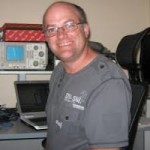Posts Tagged ‘codec2’
 LHS Episode #183: All the Acronyms
LHS Episode #183: All the Acronyms
 Hello, listeners! In this episode the Linux in the Ham Shack crew talks about topics including new 60-meter allocations, updates to codec2, the Batbeam antenna, quantum computing, an amateur radio-related cape for Raspberry Pi, morse code decoders, Hamvention and much more. Thank you for downloading this episode and giving it a listen. Don't forget to send us feedback. We're on all the social media networks and we even have a call-in feedback line at +1-909-547-7469.
Hello, listeners! In this episode the Linux in the Ham Shack crew talks about topics including new 60-meter allocations, updates to codec2, the Batbeam antenna, quantum computing, an amateur radio-related cape for Raspberry Pi, morse code decoders, Hamvention and much more. Thank you for downloading this episode and giving it a listen. Don't forget to send us feedback. We're on all the social media networks and we even have a call-in feedback line at +1-909-547-7469.
73 de The LHS Crew
 LHS Episode #145: Screaming Peanuts
LHS Episode #145: Screaming Peanuts
 Hello, friends! We're back with another fine episode of Linux in the Ham Shack. In this episode, we tackle topics like digital voice, the release of the 4.0 Linux kernel, installing or running Linux from a thumb drive, and a few rants from the peanut gallery. Please enjoy, and come back in a couple weeks for the next one!
Hello, friends! We're back with another fine episode of Linux in the Ham Shack. In this episode, we tackle topics like digital voice, the release of the 4.0 Linux kernel, installing or running Linux from a thumb drive, and a few rants from the peanut gallery. Please enjoy, and come back in a couple weeks for the next one!
73 de The LHS Guys
 LHS Episode #138: Being David Rowe
LHS Episode #138: Being David Rowe
 How about that: It's the first episode of Linux in the Ham Shack for 2015! We hope everyone is having a great new year so far. In this episode, we talk with David Rowe, VK5DGR, of Adelaide, South Australia. David is an audio engineer, Ph.D. scholar, inventor of Codec2 and co-author of FreeDV, among his many accolades. We talk to David about his projects, Linux, amateur radio, life in Australia, LinuxConf AU, the new SM1000 FreeDV device, the amount of energy it takes to make a Krispy Kreme donut, home built electric cars, and much more. Until next time...
How about that: It's the first episode of Linux in the Ham Shack for 2015! We hope everyone is having a great new year so far. In this episode, we talk with David Rowe, VK5DGR, of Adelaide, South Australia. David is an audio engineer, Ph.D. scholar, inventor of Codec2 and co-author of FreeDV, among his many accolades. We talk to David about his projects, Linux, amateur radio, life in Australia, LinuxConf AU, the new SM1000 FreeDV device, the amount of energy it takes to make a Krispy Kreme donut, home built electric cars, and much more. Until next time...
73 de The LHS Guys
 Show Notes #099
Show Notes #099
Introduction:
- Apologies for the tardiness of the show notes for Episode 99. I spent a few days in warmer climes, neglecting my duties. -Bill, KA9WKA
- Welcome to episode 99 of Linux in the Ham Shack.
Announcements:
- Linuxfest Northwest has announced their Call for Papers, Sponsors and Exhibitors. The show will be at Bellingham Technical College in Bellingham, Washington on April 27th and 28th, 2013. Visit their website for more information.
- Donations for LHS to be at the 2013 Dayton Hamvention are already rolling in. Thank you to everyone who has contributed so far. Please send anything you can. Even a dollar helps out. Donate here!
- The Wouff-Hong Podcast has been announced. It will star Tracy Holz, N5UNX and Joel McLaughlin, W3RAZ. Joel is also a co-host of the long-running Linux Link Tech Show podcast. Tracy has been a guest on many podcasts and also did his own show, Working in the Open, a couple of years ago. The show will be ham radio focused, with topics ranging from operating practice to folklore to hardware. Tracy is currently co-hosting The Techie Geek podcast with Russ Wenner.
- Things to do:
- Sign up for the LHS mailing list.
- Become a subscriber for $2/month or $20/year. That donation does count towards the Dayton Hamvention fund.
- Record a little memento for the 100th episode. Tell us you like us, or hate us, or whatever. Just let us hear from you. Leave your voice message at +1-909-547-7469. (By the time these notes are published, the 100th episode has already been recorded. However, feel free to leave a message, anyway!)
- Check out the Events and Ambassadors pages on the LHS site. If you can help us out by being at an event for us, please let us know. We provide the booth setup and a free T-shirt or ball cap. You provide a presence and a demo computer. Everyone has a good time.
- Join the LHS IRC channel. We are at #lhspodcast on Freenode (irc.freenode.net), and there’s almost always someone to chat with. Plus you can participate in the live show that way.
- Listen to the live show every other Tuesday night at 8:00pm Central. You get to hear all the stuff we cut out of the podcast release. Plus, if you’re in the IRC, your experience is twice as fun. The URL to listen is http://stream.blacksparrowmedia.net:8008/lhslive.
- Join the Linux in the Ham Shack Google+ Community.
- Follow LHS on Google+, Identi.ca and Facebook. Also, follow BSM_Network and LHSPodcast on Twitter.
Topics:
- FreeDV is a GUI application for Windows and Linux (MacOS and BSD are in testing) that allows any SSB radio to be used for low bit rate digital voice. It appears to be using Codec 2!
- Hamux 6 is a CentOS-based repository with ham radio software. It is compatible with the Extra Packages for Enterprise Linux (EPEL) project. It works with CentOS 5 and 6, and i386 and x86_64 versions are now available. It’s not a distro, but repackaged RPMs for RHEL and CentOS. It does require EPEL (Extra Packages for Enterprise Linux).
- Fedora 18 has finally been released, and Russ shares his experience with this much anticipated, and often delayed, release. Russ provides a brief and not very favorable, review.
- Richard suggests trying SliTaz GNU/Linux.
Feedback:
- Leif, KC8RWR (in reference to our discussion of using short wave radio for Internet connectivity in Episode 98), offers his thoughts.
- Dave, M0DCM, also chimes in with some comments about high-speed Internet over HF.
Contact Info:
- Contact Richard at [email protected], Russ at [email protected], or both at the same time at [email protected].
- Listen to the live stream every other Tuesday at 8:00pm Central time. Check the LHS web site for dates.
- Leave us a voice mail at 1-909-LHS-SHOW (1-909-547-7469), or record an introduction to the podcast.
- Sign up for the LHS mailing list.
- Sign up for the MAGNetcon mailing list.
- LHS merchandise is available at the Merch link on Web site. Check out the Badgerwear or buy one of the other LHS-branded items at PrintFection.com/lhs or Cafe Press. Thanks!
- Thanks to Dave from Gamma Leonis for the theme music.
Music:
- “Drinkin’ Problem” by Freeky Clean & Dickey F from the album South of Pearly Gates, courtesy of Jamendo.
- “Writing on the Wall” by Freeky Clean & Dickey F from the album Double Feature, courtesy of Jamendo.
 LHS Episode #099: Thorpe Your Octo
LHS Episode #099: Thorpe Your Octo
 We are one episode away from the century mark. It’s with a great deal of pride that we, the hosts of Linux in the Ham Shack, present to you our 99tieth episode. We would love to have some audio feedback from as many of our listeners as we can get that we can air on our 100th Episode Extravaganza. If you have the time and inclination, please submit a sound bite telling us how much you love the show, or hate it, or whether a weasel stole your chickens. It doesn’t matter; we just want to hear from you! In the meantime, since Russ actually sat down and did some research for the episode, please take a listen and try to glean from it whatever nuggets of wisdom you might find. We’re not saying they’re in there, but the journey to discovery has been fun so far.
We are one episode away from the century mark. It’s with a great deal of pride that we, the hosts of Linux in the Ham Shack, present to you our 99tieth episode. We would love to have some audio feedback from as many of our listeners as we can get that we can air on our 100th Episode Extravaganza. If you have the time and inclination, please submit a sound bite telling us how much you love the show, or hate it, or whether a weasel stole your chickens. It doesn’t matter; we just want to hear from you! In the meantime, since Russ actually sat down and did some research for the episode, please take a listen and try to glean from it whatever nuggets of wisdom you might find. We’re not saying they’re in there, but the journey to discovery has been fun so far.
73 de The LHS Guys
 Show Notes #098
Show Notes #098
Introduction:
- A Futile Exercise in Focus, or perhaps a feudal exercise. Stay tuned and find out.
Announcements:
- Listen to us live Tuesday evenings (in the USA), or subscribe and receive access to the unedited recording and other things. Visit the website for details.
- We’re in dangerous proximity to episode 100, so send in comments, suggestions, voice mail, Facebook, Google+, or carrier pigeons.
- All you podcasters out there, join the Black Sparrow Media network.
- The 2013 Dayton Hamvention will be May 17-19, 2013. Russ is hoping to have the LHS booth again, but we need your help. Please donate if you can. Every little bit helps.
- Kevin O’Brien, Publicity Director for the Ohio LinuxFest, tells us that they have set up a brief survey to gather ideas for the 2013 Ohio LinuxFest. Visit http://ohiolinux.org/ to find the survey.
- Northeast Linux Fest will be March 16th and 17th, 2013, at Harvard University in Cambridge, Massachusetts.
Topics:
- Russ’ Raspberry Pi adventures continue. His Echolink node 54711 is now up and running on a Raspbian-based Raspberry Pi with svxlink and Qtel. Russ had to insert “dwc_otg.fiq_fix_enable=0″ into the /boot/cmdline.txt file in order to fix a problem with the onboard Ethernet card locking up. Since then, all has been well.
- Amateur Radio Pi is a forum with the tagline: The interactions between amateur radio and the Raspberry Pi.
- The Society for the Preservation of Amateur Radio (SPAR) will conduct a Winter Field Day, beginning 1700Z on January 26, 2013 and ending at 1700Z January 27th.
- HamSphere is a software Amateur Radio simulator that allows licensed radio amateurs and unlicensed enthusiasts to communicate with one another using a virtual transciever over the Internet. It was designed by Kelly Lindman, a radio amateur with callsign 5B4AIT. The software runs under Windows, Mac or Linux. There’s also a Wikipedia page for more information.
- RepeaterBook is an Android application for locating amateur radio repeaters. There are lots of options, including repeater types and modes (D-Star, etc). It also supports the BlueCAT Yaesu FT-857/FT-817 interface that allows you to tap a repeater entry in RepeaterBook on the phone and it will set your radio frequency.
Feedback:
- Comment via the Web site from Leif, KC8RWR, with another attempt at explaining hard and soft links, which we were discussing in episode 95. Thanks, Leif.
- Leif also commented about difficulties hearing a mobile radio without a speaker in the head unit.
- A very strange voice mail from the Radio Gangsta, aka Rich, KD0RG, from the LowSWR podcast.
- E-mail from gasgasmike, asks if it would be possible to use short wave radio to provide wireless Internet service. Our hosts discuss the practical difficulties with such a scheme. (Note: the use of the amateur portions of the radio spectrum for commercial purposes is expressly prohibited by the FCC.)
- Jeff, KC2QZO, sends his appreciation of our discussion of Codec2 in episode 85.
- Russ mentions that there is another low-bitrate codec is being developed: The Opus Interactive Audio Codec.
Contact Info:
- Contact Richard at [email protected], Russ at [email protected], or both at the same time at [email protected].
- Listen to the live stream every other Tuesday at 8:00pm Central time. Check the LHS web site for dates.
- Leave us a voice mail at 1-909-LHS-SHOW (1-909-547-7469), or record an introduction to the podcast.
- Sign up for the LHS mailing list.
- Sign up for the MAGNetcon mailing list.
- LHS merchandise is available at the Merch link on Web site. Check out the Badgerwear or buy one of the other LHS-branded items at PrintFection.com/lhs or Cafe Press. Thanks!
- Thanks to Dave from Gamma Leonis for the theme music.
Music:
- None this episode.
 Show Notes #090
Show Notes #090
Introduction:
- Join us this episode as our intrepid hosts, Richard and Russ (mad posstcatter!), interview John Hays of NorthWest Digital Radio.
Topics:
- Interview with John Hays (K7VE) from NorthWest Digital Radio.
- John has been a licensed amateur radio operator for 40 years. His wife and all of his children are hams, too!
- A couple years ago John gave a presentation at TAPR, and discussed his wish for a reasonably priced radio for digital communications with just a few connections: antenna, power and Ethernet.
- Bryan Hoyer (now K7UDR) approached John and volunteered to build one. Their collaboration (with Basil Gunn) resulted in NorthWest Digital Radio.
- Their first product will be the UDR56K-4 Universal Digital Radio, planned for availability in early 2013.
- John goes on to discuss the features of their digital radio and some of the design decisions the company made.
- Specifications (subject to change, of course):
- 25W 70cm Transceiver
- 4800 to 56Kbps
- FSK, GMSK, 4FSK
- Open Source Linux Platform — a full Linux-based web server is built-in. It uses the Debian kernel, running on an ARM processor (faster than a Raspberry Pi).
- Web Interface over Ethernet
- 4 USB Host Ports
- Applications:
- The radio can be completely controlled through the web interface or the command line.
- John talks about other potential applications for their radio platform.
- Keep an eye on the website for more information and to sign up for email announcements.
- You may also be interested in John’s blog.
Contact Info:
- Contact Richard at [email protected], Russ at [email protected], or both at the same time at [email protected].
- Listen to the live stream every other Tuesday at 8:00pm Central time. Check the LHS web site for dates.
- Leave us a voice mail at 1-909-LHS-SHOW (1-909-547-7469), or record an introduction to the podcast.
- Sign up for the LHS mailing list.
- Sign up for the MAGNetcon mailing list.
- LHS merchandise is available at the Merch link on Web site. Check out the Badgerwear or buy one of the other LHS-branded items at PrintFection.com/lhs or Cafe Press. Thanks!
- Thanks to Dave from Gamma Leonis for the theme music.











